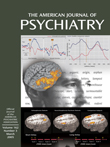To the Editor: Dr. Richelson and colleagues express the standard view that a neurotensin receptor agonist might be more likely to have antipsychotic potential than a neurotensin antagonist. There is, however, evidence that neurotensin increases the firing rate of the ventral tegmental dopamine neurons that project to the mesocorticolimbic system, which might be expected to be etiologically relevant to positive symptoms in schizophrenia, and that this effect is blocked by neurotensin antagonists
(1). The latter effect is similar to that of typical and atypical antipsychotic drugs and is believed to contribute to their antipsychotic action. SR48692 is, in fact, active in some preclinical models that suggest antipsychotic activity
(2,
3). It is noteworthy that intravenous injection of SR48692 and SR142948, another neurotensin antagonist, as well as haloperidol and clozapine, induced a dose-dependent inhibition of firing rate in two-thirds of the neurons in the ventromedial part of the ventral pallidum. The pattern of the effect of SR48692 was comparable to that of clozapine, the prototypical atypical antipsychotic drug, and more specific than that of haloperidol.
We note that based upon the hypothesis that neurotensin agonism has an antipsychotic action, a worsening of psychosis in the patients who received SR48692 compared to placebo would have been predicted. This was not observed. We await with interest the results of clinical trials with the neurotensin agonist NT69L in schizophrenia and hope that it will have greater efficacy than was observed with SR48692. An antipsychotic action of NT69L would constitute a rejection of our hypothesis that a neurotensin agonist should have antipsychotic activity and cast doubt on some of the animal models that led to the testing of SR48962.
We thank Drs. Robertson and Wilson for their interesting comments on our report of the efficacy and tolerability of four novel compounds in the treatment of schizophrenia. The report by Berk and colleagues
(4) of the ability of mirtazapine differs in two important aspects from our report of the ability of SR46349B, which diminish its relevance for our article; we can cite only the most highly relevant literature here. First, mirtazapine has a much more complicated pharmacology than SR46349B, which is a highly selective 5-HT
2A/2C antagonist, e.g., mirtazapine is also a potent α
2-adrenoceptor antagonist, so that it is not possible to attribute any benefit it may have in schizophrenia solely to its effect on 5-HT
2A/2C receptors, as is the case with SR46349B. More important, the study of Berk and colleagues was an augmentation study: mirtazapine was added to haloperidol, whereas SR46349B was given as monotherapy to acutely psychotic patients. There is no evidence that we are aware of that mirtazapine is effective as monotherapy for patients with schizophrenia. We did cite evidence that M100907, a highly specific 5-HT
2A antagonist, is useful, to some extent at least, in treating schizophrenia.
We agree with Drs. Robertson and Wilson that a single analysis method should be prespecified for each type of data. In fact, we have adhered to this principle, and thus, their criticism of the statistical analysis performed is mistaken on two counts. First, the Barnes Rating Scale was not analyzed as a dichotomous variable but as a three-level variable (worsened, no change, or improved). This is quite clearly stated in the Methods section. For this reason, we chose the Cochran-Mantel-Haenszel row means score test, which is more appropriate to an ordinal variable than Fisher’s exact test. Second, all statistical testing methods were specified in an analysis plan prepared before the data were unblinded. Therefore, it is incorrect to conclude that Fisher’s exact test was selected based on its significance or lack of such for any particular adverse event. We should perhaps have made this clearer in our article.

